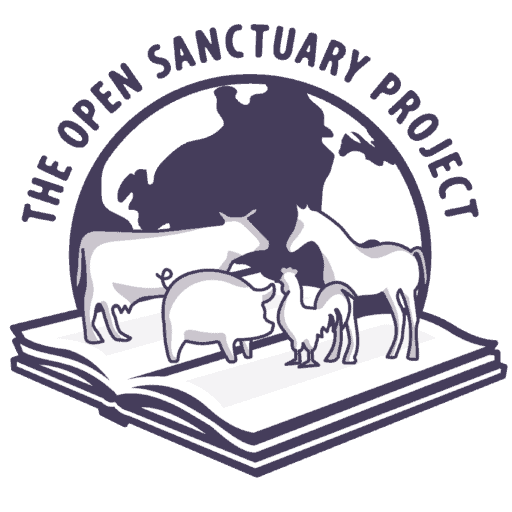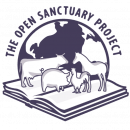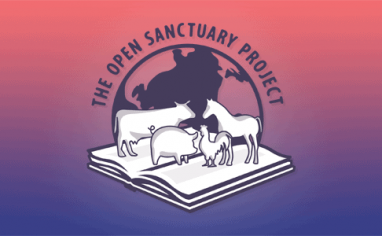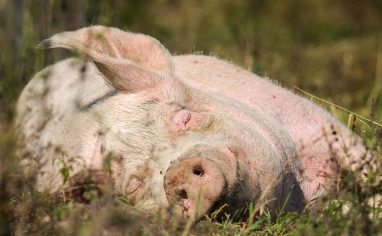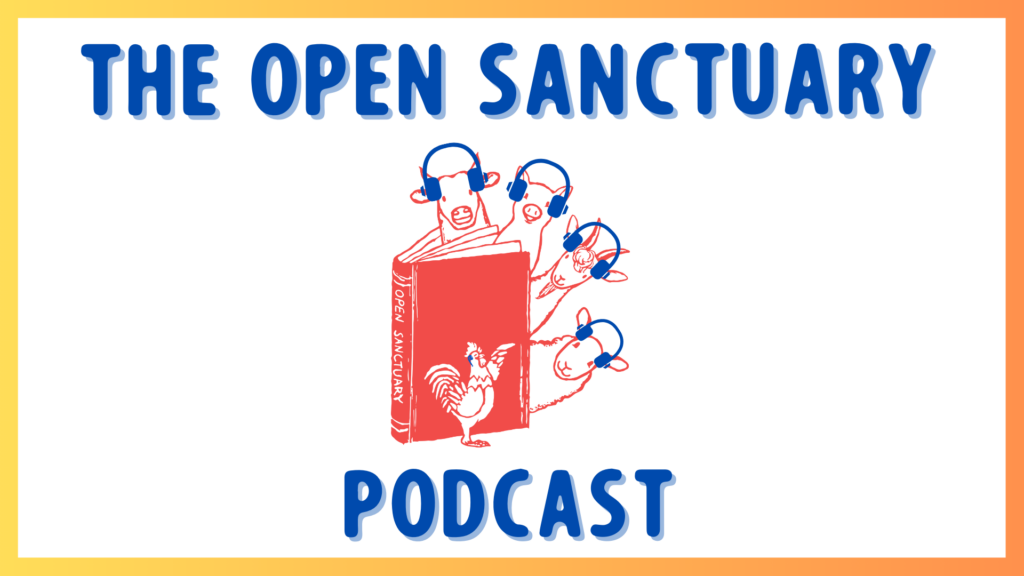
Subscribe To The Open Sanctuary Podcast
If you’d like to get the latest episodes of The Open Sanctuary Podcast, you can subscribe for free on all Podcast platforms, including Apple Podcasts and Spotify!
Episode Notes
In this episode of The Open Sanctuary Podcast, Senior Advisor Tara and NonprofitA non-governmental organization whose primary purpose is something other than selling goods or services. Specialist Julia discuss the guiding principles we use to source compassionate care information. From discussing the challenges of finding reliable sources that value the individual lives of animals as sentient beings to explaining how we assess specific care recommendations, we hope that this podcast can provide you with more specifics on how you, too, can evaluate information more carefully, and feel a little less overwhelmed as you do so!
—
This Episode’s Referenced Open Sanctuary Project Resources:
- About The Open Sanctuary Project
- Information Sourcing Considerations At The Open Sanctuary Project
- What Does “Non-Compassionate Source” Mean At The Open Sanctuary Project
- A Guide To Evaluating Farmed AnimalA species or specific breed of animal that is raised by humans for the use of their bodies or what comes from their bodies. Care Sources, Recommendations, And Information For Your Sanctuary
- Backyard ChickenThe raising of chickens primarily for the consumption of their eggs and/or flesh, typically in a non-agricultural environment. Recommendations In Sanctuary: A Word Of Caution
- The Open Sanctuary Project’s Elder Care Resources
- Daily Diet, Treats & Supplements For CowsWhile "cows" can be defined to refer exclusively to female cattle, at The Open Sanctuary Project we refer to domesticated cattle of all ages and sexes as "cows."
- Predator-Proofing For Bird Residents At Your Sanctuary
- Advanced Topics In Resident Health: Avian Influenza In Birds
- HPAI In DomesticatedAdapted over time (as by selective breeding) from a wild or natural state to life in close association with and to the benefit of humans Ruminants And Camelids: FAQ
Episode Transcript (Auto-GeneratedThe following content was transcribed through an automated process and may contain transcription errors or misspellings.)
Julia Magnus: Hi, sanctuary friends and family. We’re back with another episode of the Open Sanctuary podcast. I’m Julia, the nonprofit specialist at the Open Sanctuary Project, and I’m with Tara Hess, our senior adviser. Just to give you a little reminder, if you’re not familiar with us, the Open Sanctuary Project is a freely accessible, always growing digital guide for any resources or information you need in order to responsibly create and successfully manage an animal sanctuary or to provide the best possible care to animals in order to help them live long, healthy, happy lives free of exploitationExploitation is characterized by the abuse of a position of physical, psychological, emotional, social, or economic vulnerability to obtain agreement from someone (e.g., humans and nonhuman animals) or something (e.g, land and water) that is unable to reasonably refuse an offer or demand. It is also characterized by excessive self gain at the expense of something or someone else’s labor, well-being, and/or existence.. All of our resources are researched and responsibly crafted with the intention of promoting compassionate care standards and practices for animals in need of help in the sanctuary, while we also identify and discourage practices that are exploitative or harmful to the individual. So, one really important part of this job is locating sources of information, right? An important and sometimes super challenging part of the job. Folks who have looked at our resources may have noticed that at the base of almost every resource we have, we provide a list of sources which include websites, organizations, articles, scientific journals, and books. We’re committed to providing our audience with a transparent accounting of where we’re gathering our information from, which often by nature of the state of animal agricultureThe human production and use of animals in order to produce animal products, typically for profit. relies upon non-compassionate sources that focus on things like productivity, profits, performance, and perpetuate a culture of exploitation. We try our best to cite our information from compassionate sources when we can, but sometimes this just isn’t possible. We continue to work toward our vision of a world free of exploitation to animals of all species, but in the meantime, we work with what we have to help sanctuaries help animals as effectively as possible. I want to jump in here because one thing that’s kind of important to mention is artificial intelligence or AI.
Julia Magnus: So, it may seem like the exponential proliferation of AI means that getting this kind of information quickly could be easier, but AI draws from all kinds of sources without discrimination, some of which may not be in line with compassionate care values. For that reason, we want to point out that we do not use AI for substantive work. We have, in fact, developed an AI policy for full transparency to our community. The only places where we do use AI occasionally is for help in brainstorming social posts, which we will then edit, or with certain kinds of graphics. We do have that policy in our show notes. So, if you’d like to check it out and see how we stand on that, you can go ahead and do so. In this podcast, we want to run through some of the challenges that we face and considerations that we use when we’re assessing information for our resources, and we can talk a bit more about some examples of how we’ve worked around challenges and employed careful thought to sourcing. And we really hope this resource can provide you with more specifics on how to look at various kinds of information sources and care recommendations so you can assess them more easily and feel a little less overwhelmed by all that is out there. Let me note that we do also have a resource on this subject and that we have a lot more detail on these kinds of challenges and how we address them. We’ll also include that in the show notes, but let me list out some of the challenges that you particularly have identified over time, and maybe you can offer some examples of how you’ve addressed them in the past. Point one: societal views of animals. Point two: the widespread influence of animal agriculture on care information. Point three: the fact that anyone can be an expert. And then point four: the fact that in some cases, information may simply not exist, or at least not yet.
Tara Hess: Yeah. So, these challenges come up a lot, and I think depending on the topic we’re researching, it might be that some of these are particularly prevalent, or all of them. So, I think talking about our elder care resources really encapsulates how these challenges affect the information that’s available.
Tara Hess: So when you’re out there looking for info, these challenges that Julia just listed are going to impact what you find and how good or not good that information might be. Because of the way our society views farmed animal species, the idea of elderly farmed animalsA species or specific breed of animal that is raised by humans for the use of their bodies or what comes from their bodies. is rather novel outside of sanctuary spaces. I mean, many people never even consider the possibility of elderly farmed animals. And so then you add in the influence of animal agriculture and the fact that most individuals of these species are living within the confines of animal agriculture, and then this really skews the information that’s out there about things that might be as basic as life expectancy. So when animals are routinely killed at a young age, how does anyone really know what constitutes elderly or what type of care an elderly individual might need? Of course, animal sanctuaries that have been doing this work have learned a lot about elder care over the years, but in terms of finding veterinary information or scientific information, that’s much harder to come by. So, if I’m going through trying to find information, or for our listeners, if you’re Googling and trying to find information or checking out your library, if you can’t find these sources that might be more official, like a veterinary source or some sort of scientific source, then you might just be left with other more random sources, like a blog or maybe a really official website, something that looks official, but you actually can’t figure out who’s writing it or what their experience is or what their background is. And so then we have no way really of knowing not only how knowledgeable the person presenting this information is, but where there might be gaps in their knowledge because these sources and this information that we’re talking about, it’s not like this neatly packaged thing, or like, “Oh, look at this source. Every single thing they say is good and perfect and can be used.” Sometimes it’s a sifting through of like, “Oh, this is great, this is great,” and then there’s like a big red flag around something else.
Tara Hess: And so without understanding where those gaps in someone’s knowledge are, or what their views of animals might be, it might be harder to find where those red flags might be. So, I’m thinking now you could come across a chicken forum, like a backyard chicken forum, or a really fancy, there are so many fancy backyard chicken websites. You could come across something that suggests that a Cornish cross can’t live past the age at which they’re typically slaughtered. And sanctuary stories have proven time and time again that it’s quite possible for a Cornish cross to live even past the age of 10. But if you don’t know that, then you’re going to have a hard time gauging this information where they’re saying that’s not possible. And to be fair, it’s not just random bloggers who perpetuate this myth. Even some veterinarians still believe that. So, given the fact that there’s this massive misconception about their life expectancy, you’re going to be hard-pressed to find good information about how to actually care for them in old age if the source doesn’t believe that that’s even possible. Another thing that I think really highlights some of these challenges is if you think about the information that’s available about mini pigsThe term “mini pig” is used to categorize smaller breeds of pigs, such as Potbellies, Julianas, and Kunekunes, and to differentiate between these breeds and large breed pigs, such as Yorkshires, Landrace, or Hampshires, who are sometimes referred to as “farm pigs”. The descriptor “mini” can be a bit misleading- some breeds of mini pigs can weigh over 200 pounds! Terms like “teacup”, “micro”, “pocket”, “nano”, and “micro mini” are deceptive terms that are sometimes used to intentionally mislead people into thinking an individual pig will remain a certain size. who are largely considered companion animalsAnimals who spend regular time with humans in their home and life. Typically cats and dogs are considered companion animals, though many species of animals could also be companion animals. versus other breeds of pigs who are typically considered “food animals.” There’s granted not nearly as much as you might find on a dog, but you can certainly find veterinary information about the care of elderly mini pigs. Whereas if you’re trying to find information about a Yorkshire or another large breedDomesticated animal breeds that have been selectively bred by humans to grow as large as possible, as quickly as possible, to the detriment of their health. pig outside of maybe our stuff and a few other sanctuaries, it’s going to be hard to find that, and it’s definitely going to be hard to find something that’s written by a veterinarian. And of course, it’s not just farmed pigs. Arthritis is super common in most farmed animal species, but finding veterinary information about how to manage that condition that’s so common is basically non-existent for many species.
Tara Hess: So for us, navigating these challenges and creating our elder care resources was, first of all, hard to navigate because sometimes you have anecdotal information that you want to share, but maybe you want to back it up with some scientific information, which doesn’t exist. And one way we navigated this was working with experienced veterinarians to have these resources reviewed. So, we wanted veterinarians who have worked with elderly farmed animals so that they could review our information and help make sure that even though we have a careful process of assessing information, nothing slipped through the cracks where we were sharing something that maybe wasn’t the best it could be. I realize that we’re talking a lot about good versus maybe not good information, and so we should probably talk about what we mean by that. When we’re looking for good information, we want information that is accurate, current, complete, based on a clear understanding of who the individuals in question are and what they need, and is focused on the well-being of the individual. And that’s as opposed to being incorrect, outdated, overtly harmful, based on commodification, speciesismA form of discrimination based on species membership; the belief that different species of animals deserve different ethical considerations regardless of whether they have similar needs or interests., exploitation, etc., or provided without context, is oversimplified, or is too generalized. So, Julia, can you give our listeners an example of how we use these criteria to evaluate information and how this has worked out with one of our resources?
Julia Magnus: Yeah, actually, I can. And it’s not just one of our resources, but how many is it now? Seven, something like that. Basically, the challenge that was presented to us and to many of you listeners, if you’re here for avian residents or even now ruminants or camelids, is the question of highly pathogenic avian influenza. This has been very much at the forefront of our work for the past couple of years, I would say now. It is an existential threat for anyone who cares for farmed animal species at this point. And it’s one where all of these factors have come into play when we’re trying to figure out what is good information versus some that’s questionable. The reason that highly pathogenic avian influenza has been so challenging to cope with is because, first of all, it’s a double-pronged threat. There is the threat of the virus itself, which is a deadly threat, and then there is what happens if you have a detection of it either on your premises or nearby. Things change quickly with viruses. They change quickly. And so both how the virus can impact and how it may be responded to by authorities changes quickly. So, finding accurate information, for example, when highly pathogenic avian influenza made the jump from avian species into domesticated mammals like ruminants and camelids, there were a lot of unknowns. And it was very difficult to figure out what was speculation, what was proven at that point, or really truly known, established by scientists who were studying it, and also how that development impacted previous knowledge. So, at a certain point, what we thought we knew about HPAI became outdated. So, those two challenges were difficult to cope with. Also, the general treatment of this virus has been from the lens of agriculture where those affected are considered commodities, objects. And so, the response has been tailored from that lens and is clearly overtly harmful to our perspective of these animals as individuals whose lives are valued. It’s also very much based on commodification and speciesism. The only concern generally with response to HPAI from officials is in protecting trade, not with the lives of individuals. And so the response legally has been generally stamping out or depopulation.
Julia Magnus: For birds.
Tara Hess: We should just, for folks who haven’t been keeping up, that yeah, that’s been for birds because speciesism has been at play and it has played out differently for cows, not that we want cows to be killed, but you know, cows are more valuable in the eyes of the industry, harder to replace.
Julia Magnus: Yeah, totally agree. And I feel like that’s also leading us into our other point, which is somehow cows are more valued from that lens, but not because they’re individuals, because they’re more valuable. And so, initially, we’re kind of sitting, waiting with bated breath to see what the response would look like, and maybe some folks jumped to conclusions that it would be treated in the same fashion that it has been with avian. So, it’s been really critical for us to make sure to account for those nuances, not to scare people unnecessarily, but also to provide all of this information with the wider context of impacts on every individual. So, how we’ve kind of threaded that needle has been to rely on official sources. Official sources that have both scientists at work and also some say on legal response. So, we’ve looked closely and we follow closely USDAThe United States Department of Agriculture, a government department that oversees agriculture and farmed animals., APHIS, the World Health Organization. We look at because sometimes things will be announced on state governmental websites before they are on USDA. We look at those. We carefully sort through all the information that comes through on the hundreds of Google alerts that come every single day to make sure that we can verify what claims are being made, and if we can’t, we don’t share information that we can’t trust. But it’s definitely been a challenge, and I feel like it’s challenging for all of us, but this has been a particularly difficult moment when it comes to information sourcing at OSP.
Tara Hess: Yeah. And I just want to throw in, I feel like it’s— I don’t know if “extreme” is the right word, but I mean, it’s a really good example because things have been happening so quickly, just to show— I mean, Julia and I would write something, and before we could get it published, it was outdated. That’s how quickly things were changing when it first was detected in cows. So, that does make it a good example for what we’re trying to illustrate here. But it’s certainly not just having to do with disease outbreaks. I find that this happens with other diseases too that have been around, that haven’t made these wild changes where now they’re affecting other species, but still, sometimes it takes a while for scientists to really learn how certain diseases spread. So then, how we think we can do to protect residents has to adjust as they learn more about how diseases spread. So, I just wanted to mention that because I feel like HPAI is a really extreme example, but it’s certainly not the only time that sources sort of jump between these two. I feel like sometimes it’s clear-cut where it’s like it’s good or it’s not good, and then sometimes it sort of moves from the good category down to the “it’s not good anymore.”
Julia Magnus: Yeah, I agree with you. I do feel like it’s a pretty extreme example, but the way that we’ve decided to approach it kind of brings up all of the questions that we use when we’re assessing sources internally for resource use. So, let me parse out some of those questions, and maybe you can give some examples of how you’ve used those questions to assess sources for certain of our resources.
Tara Hess: Okay. So, question one: Who’s behind this source? What is their experience? Are they well-suited to speak about the subject at hand? Question two, this is about their views: How do they view farmed animals, and how might that affect the information they share and what they recommend? Question three is: Who is their intended audience? That’s a big one. And then four: Can you tell where they got their information? So, this makes me think about writing and researching some of our diet resources. I remember feeling like I wanted to pull my hair out working on the cowWhile "cow" can be defined to refer exclusively to female cattle, at The Open Sanctuary Project we refer to domesticated cattle of all ages and sexes as "cows." diet resource, even though I felt like it should be pretty straightforward in terms of what the recommendations should be based on what sanctuaries have done that has worked, but I also wanted to have something to back it up with so it wasn’t just anecdotal information. And one common type of source that I kept coming across were things put out by various cooperative extensions. And so these folks have a lot of experience, so it’s fair to say that they are well-suited to speak to the subject of what is an appropriate diet for cows. But when you think about what type of experience they have and also who their audience is, that really affects what information they’re putting out. So, part of my frustration with creating this resource was that almost everything I found that felt like it was from a legit source that I would feel okay sourcing—and I don’t mean “okay sourcing” in terms of it being compassionate, I just mean in terms of feeling like it was a sound resource where I could tell where the information was coming from, I could tell that there was some science backing it up—pretty much everything was focused on what do pregnant cows need and what do lactating cows need. Now, of course, a sanctuary could rescue a pregnant individual or somebody who’s lactating, but that is not the primary thing that sanctuaries are looking for in terms of information. For the most part, they’re looking for information about what does a cow who is living, not pregnant, not lactating, what do they need? And so I was having a really hard time taking what I personally knew about feeding cows and the information that was out there and making sense of it all. And I reached out to a few cooperative extension agents who were super friendly and were happy to help if they could. But one of them did explain to me that cooperative extension agents were bound by their missionThe stated goals and activities of an organization. An animal sanctuary’s mission is commonly focused on objectives such as animal rescue and public advocacy. to provide science-based, research-proven answers, which sounds wonderful, like that’s what I’m looking for, but that there just isn’t any research to support the nutritional needs of non-producing—so, non-lactating, non-pregnant cows. So, going back to us saying the information just doesn’t exist, outside of sanctuary spaces, what I was looking for just didn’t really exist. On the other side of things, those are sources where yes, I could tell where the information was coming from. I knew what sort of experience they had. I could tell who their audience was, even if it wasn’t me. On the other side of things, you might come across just a homesteading website where someone talks about what they feed their cow, but you really have no idea what their background is, what sort of knowledge they have, maybe even who their audience is. And so I don’t want to use that if I can’t tell where the information is coming from. I should say as a side note, I’m sure you’ve seen this too, Julia, when you really go down, you’re doing all this research and looking at a million resources, you’ll start seeing how certain sources are either plagiarizing other sources or you’ll realize that they took this information you already came across and misconstrued it and relayed it. And so anyway, I just think that that’s interesting and that’s where it’s really important to realize where people get their sources from because if they’re not being explicit about where they’re getting their sources from or their information from, it can be easy to miss that. It’s like the game of telephone where they’ve relayed it incorrectly.
Julia Magnus: Oh yeah, let me chime in real quick on that because one thing that’s funny that’s happened quite a few times is we’ve seen our own sources plagiarized. We’re always like, “What just happened?” And sometimes it isn’t funny because it’s like, “Whoa, this person just took this and put it in this context, which we absolutely do not support.” Now, let’s be clear, it’s fine for you to share our sources. We have a sharing policy, which you can also include in the show notes if you want to know how to share our resources. We’re happy to have this information out here. But it’s not always the best when we see people take stuff that was clearly something we produced and then just do it in a way that’s not ideal.
Tara Hess: Yeah. Yeah, it’s definitely not actually funny, but there’s something really surreal when you’re like, I’m going to update this resource or see if it needs updating, and then you do research and you see that very resource is somewhere else. You’re like, “Jokes on you because I’m updating it.” Anyway, so after that little segue, or tangent, I guess it was more of a tangent. In the end, we were able to put something out that we felt good about in terms of cow diet, but it wasn’t easy is the point. We had to sift through a lot of information to figure out what was appropriate for our purposes and what wasn’t while still feeling like the recommendations we were making had some sort of backing. Because just like we want, when I’m looking at a source, I want to be able to tell where they got their information. We want people to be able to tell where we got our information. So, we’re not just like, “OSP says to do this,” and who knows where it comes from. So, in addition to assessing sources, which we just talked about, you have to assess specific care recommendations. Like I mentioned earlier, you could have a source that’s decent, but that doesn’t mean that every single recommendation they make is actually good or appropriate. So, when we’re going through specific care recommendations, we ask ourselves a set of questions, and those questions are: First, whose needs are at the forefront? Then, is this coming from a source qualified to make recommendations on this subject? Does the recommendation harmThe infliction of mental, emotional, and/or physical pain, suffering, or loss. Harm can occur intentionally or unintentionally and directly or indirectly. Someone can intentionally cause direct harm (e.g., punitively cutting a sheep's skin while shearing them) or unintentionally cause direct harm (e.g., your hand slips while shearing a sheep, causing an accidental wound on their skin). Likewise, someone can intentionally cause indirect harm (e.g., selling socks made from a sanctuary resident's wool and encouraging folks who purchase them to buy more products made from the wool of farmed sheep) or unintentionally cause indirect harm (e.g., selling socks made from a sanctuary resident's wool, which inadvertently perpetuates the idea that it is ok to commodify sheep for their wool). animals directly or indirectly, such as by reinforcing stereotypes or commodification? Does it fit with what we know about these individuals and the care they require and deserve? What is the ultimate goal of this recommendation? What risks, if any, come with following the recommendation? Are there other ways to achieve a similar outcome but with fewer or no risks? And can I find other trusted sources that support this recommendation? We like to follow the rule of three, which sometimes is hard to do, but can we find two additional trusted resources? So, we have three things that are saying about the same thing. So, Julia, can you talk us through an example of how this has played out for us?
Julia Magnus: Sure. One resource we worked on together had to do with avian predator-proofing for sanctuaries. That was a challenging resource to write because there are so many opinions on this issue, and many in the backyard chicken community. Among many other issues is the question of centering avian resident needs as prey animals first and foremost. So what this means is centering the question of the reality of predator threats to them. So let me be clear, I live in a city with multiple flocks of chickens in my care, and often I see from backyard chicken recommendations in the city advice to the effect that there are no predators in the city or there are no predators where we are. And I’ve even seen that from rural sanctuaries at times. I’ve seen all kinds of similar comments and associated recommendations that then minimize the importance of predator-proofing. But what I can tell you, caring for chickens in the city and having cared for chickens in other areas, is that there are predators everywhere. In our space in the city, we’ve caught videos of raccoons, coyotes, and foxes in our alley and in our yard. And I think one thing we’ve talked about at length in written resources and other podcasts is that if you care for prey animals, the predators will come. So when it comes to looking at recommendations with regard to predator protection, we realized that it was worth really centering the consideration that chickens are inherently prey animals, and their safety is important and should be centered. Following backyard chicken recommendations are not sufficient for me to care for my people, even in a city where theoretically we have no predators. I think everyone deals with very different contexts, but for us, centering the inherent nature of chickens as prey animals was really important in creating the guidance that we felt would support the well-being of prey animals in all contexts.
Tara Hess: Yeah, I think a lot of the resources or a lot of the sources we came across were coming from a place that it was either-or, like you could either protect them or they could have an enriching life. But then when you think about it, it is work and expensive to create an outdoor space that is predator-proof and spacious and enriching and all the things that we want it to be. It is a challenge, but it’s not an either-or situation, and that’s—
Julia Magnus: Yeah. And it’s so important to recognize that because you don’t have to just pick one. And just as a side note, we’ll also drop the links to the resources that we’re referencing in the show notes. So if you want to check out the avian predator-proofing or the cow diet resources, you can find them there. So yes, we have resources which outline our approach to research and information sourcing, which will also be listed in the show notes. And we also have a guide that is meant to assist animal organizations in establishing their own protocols when it comes to assessing information sources and recommendations. And that resource also has a video presentation of a presentation I did on chickens specifically. And as always, if you found this podcast useful, if you use our resources, we would really love your support. Our resources are free for the entire animal rescueAn organization that helps secure animals from dangerous or unacceptable situations. As organizations, rescues may or may not have dedicated permanent infrastructure for housing animals. and sanctuary community. But as you can see from this podcast, it can take us a significant amount of time and work to create them. If you’d like to support us, you can do so by making a donation at opensanctuary.org/donation. You can also check out our merch store. It’s pretty cool because we actually just had a fun T-shirt contest with Angry GooseUnless explicitly mentioned, we are referring to domesticated goose breeds, not wild geese, who may have unique needs not covered by this resource. winning. And so you can get for a limited time an Angry Goose T-shirt for your very own.

Got A Podcast Idea? Contact Us!
If you have a topic or question you’d love to hear our staff address on The Open Sanctuary Podcast, please get in touch via our contact form!
